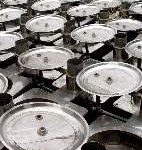Steven Chu, the United States energy secretary, has said that if other countries do not impose carbon dioxide emissions reductions, then the US would be open to introducing a carbon tariff – an import tax specifically imposed on energy-intensive products. If the US, the European Union and Japan, were to introduce such a tariff, China’s products would no longer have their low-cost advantage, and China would lose out economically to rich nations. This might appear fair for the sake of global competition, but in reality it would strangle China’s economic development. The size of the levy – and the consequences for Chinese development – would be the decision of rich nations. China would only be able to reduce its prices.
This would be unfair. Developed nations have polluted the environment and released carbon dioxide for two centuries, compared to China’s five decades of modernisation. Capital accumulation in the west was a dark period, from the Inclosure Acts, the plunder of the Americas and Africa, the slave trade and the exploitation of coolie labour, to the Opium Wars and the invasion of China by the Eight-Nation Alliance. History shows that the rich nations’ development was built on plunder. Now China is expected to fall in line with the environmental policies of the developed world.
China cannot support carbon tariffs or a carbon currency: no manufacturing nation in the process of industrialisation could. An American carbon tariff would be disastrous and would spark a trade war.
China should now increase domestic market demand to reduce the over-reliance on export markets, and put in place the new energy systems that the country urgently needs. China has two options for addressing the problem: a comprehensive reordering of domestic energy prices to increase the adoption of energy-saving and environmentally-friendly manufacturing methods; or the acquisition of cheap raw materials from overseas to act as a hidden subsidy for our leading manufacturers.
Over the past three decades, Special Economic Zones have been established to trigger and pioneer economic development. But to date, these zones have all been “high-carbon economic zones”; China does not yet have any real “low-carbon economic zones”. There is no time to waste in pushing forward this low-carbon development. The example of clean-energy vehicles, presented below, is one way that China can face the challenge.
China produced 1,000 megawatts of solar photovoltaic cells in 2007, more than any other country. But the industry’s reliance on overseas markets, both for sales and the acquisition of raw materials, mean there is no real domestic market for solar power. Nine-tenths of the solar photovoltaic sector relies on overseas markets; the global financial crisis has therefore dealt the industry a heavy blow.
At the same time, rural China has 20 million agricultural vehicles and tractors, and 40 million motorcycles, far higher than the numbers in urban areas. These “five small vehicles”: lorries, tractors, diesel-powered three-wheelers, small trucks and motorcycles, are all heavy polluters. The most effective way to break the carbon stranglehold would be to develop solar energy plants to power electric replacements for these fossil-fuel-burning vehicles.
This year the Chinese government has allocated five billion yuan (US$732 million) in subsidies for rural residents to discard their three-wheelers and low-powered trucks, in favour of light trucks or passenger vehicles with engines of 1.3-litres or smaller. But true popularisation of vehicles in rural areas will only start when they are an agricultural necessity, rather than a luxury. Light electric-powered vehicles have taken off in China; 50 million are on the roads today. A huge industry has been created in only 10 years. This can be the foundation for an electric vehicle manufacturing sector, producing vehicles costing 20,000 yuan (US$2,927) that can reach speeds of 50 kilometres per hour, which weigh less than 500 kilograms and use 10 kWh (five yuan) of electricity to travel 100 kilometres.
Vehicle-related industries employ 17% of China’s workforce. Strong growth in electric vehicles will spur domestic market demand and job creation; it is thus a crucial way to help China come out from the global financial crisis into the lead. China’s ministry of science and technology plans to have 10% of the country’s vehicle output powered by new energy in the next four to five years. Policy support for replacing agricultural vehicles with a new generation of transport will increase sales and spur the domestic market. Replacing 10 million agricultural vehicles with green vehicles that can be used in both rural and urban settings could provide 20 million jobs and create 200 billion yuan (US$29 billion) in spending.
Currently, China’s electric vehicles run on coal-fired electricity, and electric vehicles charged with coal power are even larger sources of carbon emissions than traditional vehicles. According to the EU’s Joint Research Centre, running electric vehicles on coal power would result in double the greenhouse-gas emissions of petrol- or diesel-powered vehicles. China’s ministry of finance currently plans to invest 20 billion yuan (US$2.9 billion) in manufacturing one million electric vehicles by 2010, but today these would be high-carbon “coal-powered” vehicles. Not only are solar and wind power clean forms of power, but also wind farms can provide large amounts of surplus electricity overnight, which is suitable for charging electric vehicles. The key to the large-scale use of electric vehicles – and the development of a low-carbon economy – is the use of wind and solar power to replace coal-powered electricity generation.
The Obama administration’s US$787 billion stimulus package includes investment in smart power grids, more efficient vehicles, wind and solar power. This recognises the potential in a new energy economy to end economic decline, create employment and take the lead in strategically-important industries of the future. Meanwhile, the most important matter for China is the countryside: using rural demand to drive the economy, instead of American consumers. The first task in the development of electric vehicles is to replace dangerous and polluting agricultural vehicles with green electric equivalents. Congestion in many cities means that electric bikes can be banned. Urban residents may be able to afford a 20,000-yuan electric car, but not every household has somewhere to charge it. Thus the main market for low-end electric vehicles will be in the rural areas, not the cities.
The Chinese government actively promotes vehicle use in rural areas. A preferential policy for the replacement of agricultural vehicles with electric equivalents, powered by the sun, would have a revolutionary impact on China’s vehicle sector. Market size would increase and there would be major changes in the direction of growth, product structure, sales network and capital structure. Moreover, there would be a huge increases in sales, a boost to the domestic vehicle market and an effective solution to our carbon emissions.
Dou Guanyi is head of Publicity at the Nantong branch of the Jiusan Society.
Jiang Gaoming is a professor and Ph.D. tutor at the Chinese Academy of Sciences’ Institute of Botany. He is also vice secretary-general of China Society of Biological Conservation and board member of China Environmental Culture Promotion Association. He is known for his concepts of "urban vegetation" and allowing damaged ecosystems to recover naturally.
Homepage photo by >>>Silly Rabbit, Trix are for Kids<<<


